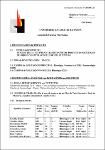| dc.contributor.author | Lacolla, Daniel Vicente (director) | |
| dc.contributor.author | Toribio, Mirta Susana (co-directora) | |
| dc.contributor.author | Hernández, Mabel Iris (investigadora) | |
| dc.contributor.author | García, Mónica (investigadora) | |
| dc.contributor.other | Corredera, César (asistente) | |
| dc.contributor.other | Buey, Valeria Graciela (asistente) | |
| dc.contributor.other | Toso, Ricardo Enrique (asistente) | |
| dc.contributor.other | Accátolli, Mauro (asistente) | |
| dc.contributor.other | Sosa, Andrés (becario) | |
| dc.date.accessioned | 2020-08-09T18:11:08Z | |
| dc.date.available | 2020-08-09T18:11:08Z | |
| dc.date.issued | 2008-07-01 | |
| dc.identifier.uri | https://repo.unlpam.edu.ar/handle/unlpam/605 | |
| dc.description.abstract | La cicatrización de una herida en la piel involucra la compleja interacción de muchos tipos celulares y componentes intercelulares y ocurre como una cascada secuencial de procesos relacionados. Si bien existen varios modelos farmacológicos experimentales para evaluar la acción cicatrizante de un principio activo, se trabajará en un modelo histológico que permita valorar la reacción de los diferentes componentes cutáneos ante la acción de principios activos cicatrizantes vegetales. Se utilizarán 60 ratones, realizándose en su dorso heridas asépticas a ambos lados de la línea media. Serán tratadas, en forma tópica, con cicatrizantes de acción conocida y con principios activos obtenidos a partir de extractos de vegetales (Achicoria, Cichorium intybus Cadillo, y Acaena myriophylla). Se considerarán también grupos control. Se aplicarán tratamiento sobre el área de la herida y alrededor de ella, hasta curación. Se realizarán determinaciones visuales, cronológicas y mediciones que permitan observar la evolución de la herida, apoyados en estudios histológicos para medir el espesor del epitelio, de la capa queratinizada, de la distancia entre el epitelio queratinizado y entre los extremos organizados del tejido de granulación. También se podrá observar, cuali y cuantitativamente, la migración celular. Se espera comprobar el efecto potencial cicatrizante de los vegetales mencionados. Estudios estadísticos complementarios permitirán determinar el grado de significancia de la acción cicatrizante de principios activos vegetales de distribución en la provincia de La Pampa. | es_AR |
| dc.description.abstract | The healing of a wound in the skin involves the complex interplay of many cell types and intercellular components and occurs as a sequential cascade of related processes. Although there are several experimental pharmacological models to assess the healing action of an active principle, we will work on a model designed to assess the histological response of the different skin components to the action of active healing plants. 60 mice will be used, carrying out aseptic wounds on its back on both sides of the midline. They will be treated topically, with healers of known action and active extracts obtained from plants (chicory, Cichorium intybus Cadillo, and Acaena myriophylla). Control groups will also be considered. Treatment will be applied on the wound area and around it, to cure. Visual and chronological determinations will be made and measurements that will allow us to observe the evolution of the wound, supported by histological studies to measure the thickness of the epithelium, keratinized layer, the distance between the keratinized epithelium and between the ends of organized granulation tissue. We will aslo be able to observe, qualitatively and quantitatively, cell migration. We expect to prove the healing potential effect of the plants mentioned. Supplementary statistical studies will determine the degree of significance of the healing action of active distribution planst in the province of La Pampa. | en |
| dc.language.iso | spa | |
| dc.rights | Atribución-NoComercial-CompartirIgual 2.5 Argentina (CC BY-NC-SA 2.5 AR) | |
| dc.rights.uri | https://creativecommons.org/licenses/by-nc-sa/2.5/ar/ | |
| dc.title | Estudio de la actividad cicatrizante de productos naturales de origen vegetal sobre lesiones cutáneas | |
| dc.type | proyecto de investigación | |
| dc.unlpam.instituciondeorigen | Facultad de Ciencias Veterinarias | |
| dc.unlpam.version | publishedVersion | |
| dc.unlpam.resolucion | 204/2008 CD-FCV | |
| dc.unlpam.monto | $8.500,00 | |
| dc.unlpam.otorgante | UNLPam | |
| dc.unlpam.fechfin1 | 2010-06-31 | |
| dc.subject.keyword | Skin | |
| dc.subject.keyword | Healing | |
| dc.subject.keyword | Chicory | |
| dc.subject.palabraclave | Piel | |
| dc.subject.palabraclave | Cicatrización | |
| dc.subject.palabraclave | Achicoria | |
| dc.subject.palabraclave | Cichorium intybus | |











